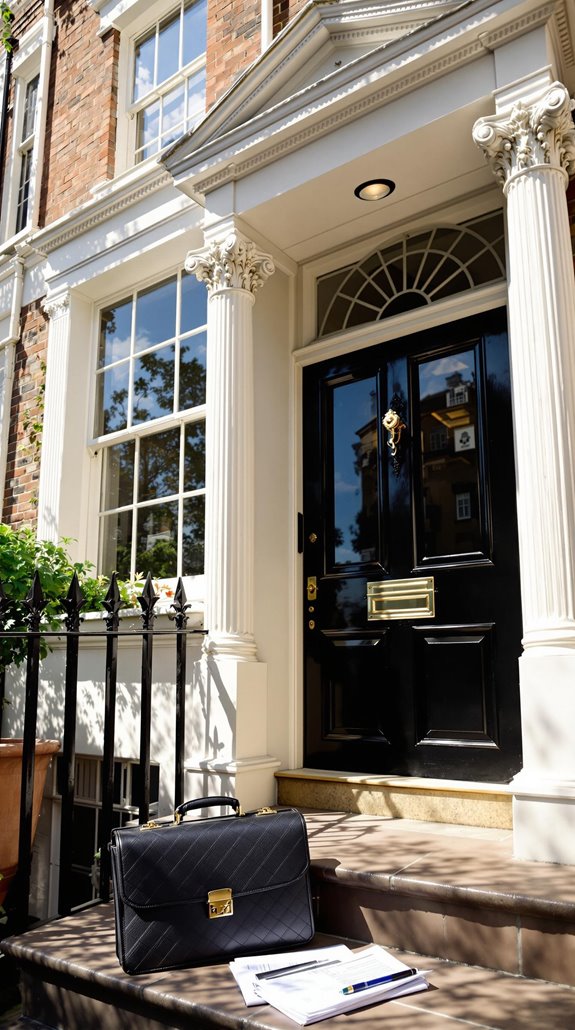I’ll be straightforward with you – if your flat’s lease has dropped below 80 years, you’re sitting on a depreciating asset that’s becoming increasingly difficult to sell or remortgage. The mathematics of lease extensions can be brutal, particularly when marriage value kicks in, but there’s a strategic window where the right legal approach can save you thousands while actually boosting your property’s worth. Here’s what you need to know about timing this significant decision.
Key Takeaways
- Professional lease extension solicitors handle Section 42 notices, negotiate terms, and ensure compliance with statutory requirements.
- Experienced legal representation is crucial for navigating the 1993 Act’s complexities and minimizing extension costs effectively.
- Starting lease extensions with 85+ years remaining avoids marriage value charges and maintains property marketability.
- Properties with leases below 80 years face £20,000-£50,000 additional costs through mandatory marriage value payments.
- Expert solicitors protect against 10-30% property devaluation by securing timely extensions before critical lease thresholds.
Understanding the 80-Year Lease Extension Threshold

When your lease drops below 80 years, you’ll face a significant financial penalty that transforms a manageable extension into an expensive ordeal. This isn’t just another legal technicality—it’s the difference between paying reasonable costs and watching your premium inflate by thousands. It’s essential to understand that Stamp Duty Land Tax may not apply when inheriting a property, but financial responsibilities can still arise.
The culprit is “marriage value,” which kicks in automatically once you cross this threshold. Your freeholder claims 50% of your property’s value increase post-extension, adding £7,000–£10,000+ to costs for a typical £200,000 flat. We’re talking about premiums reaching £12,000–£15,000 for properties at 79 years.
Here’s what makes this particularly challenging: leases at 81–83 years create buyer hesitation since ownership requirements might push the lease below 80 years before you can extend. Strategic timing above this threshold preserves your property’s marketability and protects your investment. Most mortgage lenders may refuse to lend or offer unfavorable terms when leases fall under 70 years, creating additional barriers to selling your property.
How Lease Length Impacts Your Property’s Market Value
Your property’s market value doesn’t just decline gradually as your lease shortens—it plummets at specific thresholds that can devastate your investment. I’ve seen properties lose 10-20% value with 70-80 years remaining, escalating to 20-30% losses between 50-70 years. Once you’re below 50 years, you’re facing over 30% devaluation. Understanding lease terms is crucial in these situations to make informed decisions.
The 80-year threshold triggers marriage value, making extensions costlier while accelerating devaluation. At 60 years, your property becomes “very short,” creating severe selling difficulties. Below 50 years, mortgage availability drops sharply, shrinking your buyer pool dramatically. Lenders restrict financing for sub-80-year leases, forcing you to accept lower offers. In high-demand areas like London, these penalties hit harder. Potential buyers often need to extend the lease themselves, adding extension costs to their purchase calculations. However, extending a 40-year lease by 90 years recovers that 30%+ value loss, proving strategic action pays dividends.
Marriage Value: The Hidden Cost of Delayed Extensions

Although most leaseholders understand their property’s value declines with shorter leases, they’re often blindsided by marriage value—a hidden cost that can add £20,000-£50,000 to extension premiums once leases drop below 80 years.
I’ll explain this critical threshold: marriage value represents the financial benefit created when leaseholder and freeholder interests merge. It’s calculated as the difference between your property’s value before and after extension. Unfortunately, you’ll pay 50% of this “synergistic value” to your freeholder. Understanding ground rent and other leasehold costs can help you make informed decisions about your property.
Here’s what you need to know: if your lease exceeds 80 years, you’ll pay zero marriage value. Drop below this threshold, and you’re classified as having a “short lease,” triggering substantial additional costs. Beyond the financial impact, shorter leases can create significant mortgage approval complications for potential buyers.
My recommendation? Extend before reaching 80 years to avoid this expensive penalty entirely.
Statutory Rights and Legal Framework for Leaseholders
Understanding your statutory rights transforms lease extension from a challenging negotiation into a structured legal process with clear protections. I’ll guide you through the framework that safeguards your interests as a leaseholder.
The Leasehold Reform Act 1967 and Leasehold Reform, Housing and Urban Development Act 1993 grant you enforceable extension rights. You’re no longer bound by the previous two-year ownership requirement, abolished on 31 January 2025, making extensions immediately accessible. Additionally, being informed about hidden costs can help you budget effectively for the overall financial implications of your lease extension.
Your statutory route assures fixed premium calculations and tribunal appeal rights if disputes arise. The upcoming Leasehold and Freehold Reform Act 2024 strengthens your position by eliminating marriage value for sub-80-year leases and removing your obligation to pay freeholder legal costs. A summer 2025 consultation on enfranchisement premiums will address valuation rate flaws to ensure fairer pricing structures for leaseholders.
This framework guarantees you’re protected from arbitrary pricing while maintaining clear procedural standards throughout your extension process.
Professional Valuation Process for Lease Extensions

When calculating your lease extension premium, the professional valuation process determines the exact financial cost through precise mathematical formulas and market analysis. I’ll break down how surveyors assess your premium using two key components: existing freehold value and marriage value.
Your surveyor examines current market value, projected extended lease value, remaining lease term, and annual ground rent. They’re legally required to value your property as if it already has a long lease while disregarding any improvements you’ve made. Understanding the potential impact of probate costs on an estate can also influence financial planning during this process.
The negotiation process begins when your surveyor submits an opening premium offer to your freeholder. Counteroffers follow until you reach mutual agreement. Since premium represents your extension’s most expensive element, skilled negotiation targeting alignment with initial valuation proves essential for securing favorable terms. If negotiations fail to produce agreement, the case may proceed to the First-tier Tribunal for final resolution.
Financial Investment vs. Long-Term Property Returns
Since lease extension costs can represent a substantial financial outlay, you’ll need to evaluate this investment against potential property value returns to make an informed decision.
Properties with leases below 80 years face significant value depreciation, with 70-80 year leases losing 10-20% of their worth. You’ll see steeper drops as terms shorten—50-70 years means 20-30% depreciation, while sub-50 year leases lose over 30% value. Additionally, home extension costs can vary widely based on factors like location and design complexity, which may influence your overall investment in the property.
However, extending your lease can recover these losses substantially. You’ll typically gain around 10% value increase, but shorter leases offer greater returns. A 40-year lease extended by 90 years can boost value by over 30%, while 90-year extensions yield only 5%.
The investment math works clearly: extension costs pale against value recovery, particularly for shorter leases. Understanding these dynamics becomes crucial as long-term housing yields have declined from 5.2% in the early 2000s to just 2.8% by 2023, reflecting broader economic trends affecting property investment returns.
Mortgage Accessibility and Lender Requirements

Beyond the financial calculations, your lease term directly impacts your ability to secure mortgage financing. Most lenders won’t even consider applications for properties with leases under 70 years, while many require 85 years unexpired at mortgage commencement. You’ll also need 50-55 years remaining when your mortgage term ends. Each lender has specific requirements that’ll affect your options. ModaMortgages accepts 50 years at term end, while Molo Finance demands 70 years at completion. MPowered Mortgages requires 85 years for buy-to-let properties. Halifax uses a “mortgage duration plus 30 years” formula. Properties with ground rent exceeding 0.5% of property value will be declined by most lenders. It’s crucial to seek expert legal advice to navigate these complexities effectively.
If you’re planning an extension, you’ll need legal completion before mortgage approval. This requirement means you can’t rely on future extension plans to satisfy lender criteria—the work must be done first.
Strategic Timing for Maximum Value Preservation
Understanding when to extend your lease can save you thousands of pounds and preserve your property’s value. I recommend starting the extension process when you’ve got 85+ years remaining. This timing provides an essential buffer against accidentally dropping below the 80-year threshold during the 3-6 month procedure.
Here’s why timing matters: once your lease falls below 80 years, you’ll face marriage value charges—that’s 50% of your property’s anticipated value increase post-extension. Even one day below 80 years triggers this costly penalty.
Starting at 81-82 years is risky and expensive, often costing hundreds or thousands more than necessary. Banks typically refuse mortgages below 85 years, making your property harder to sell. By extending early, you’ll lock in lower premiums and maintain maximum marketability. The upcoming Leasehold and Freehold Reform Act will eventually make extensions cheaper by abolishing marriage value charges, though these changes won’t take effect until at least 2026.
Choosing the Right Legal Team for Your Extension

When you’re maneuvering through the complex statutory framework of lease extension, selecting experienced legal representation becomes crucial for protecting your interests and avoiding costly mistakes.
Your solicitor’s expertise directly impacts your success. They’ll handle critical tasks like serving Section 42 notices, negotiating lease terms, and managing strict deadlines throughout the process. Look for specialists who understand the 1993 Act’s intricacies and have proven experience with leasehold extensions. This understanding can significantly affect the costs of leasehold property extensions and your overall investment.
The right legal team will identify all relevant parties, including intermediate landlords, and guarantee compliance with statutory requirements. They’ll protect you from overpayment through expert negotiation and handle the conveyancing process seamlessly. Professional assistance from both surveyors and solicitors is recommended to navigate the process effectively.
Don’t risk your investment with inexperienced representation. Choose solicitors who specialize in lease extensions and understand the local property market dynamics that affect your case.
Conclusion
I’ve outlined the critical factors that’ll determine your lease extension success. You’ll need to act before hitting that 80-year threshold to avoid marriage value costs. I recommend securing professional valuations early and choosing experienced solicitors who understand the statutory framework. Don’t wait – short leases kill property values and mortgage options. Calculate your investment against long-term returns, then move decisively. Your flat’s future value depends on today’s strategic decisions.
References
- https://www.leaseholdvaluations.com/impact-of-leasehold-extension-on-property-value/
- https://ajasurveyors.co.uk/what-are-the-pros-and-cons-of-a-lease-extension/
- https://www.netlawman.co.uk/ia/lease-extension-valuation
- https://www.comparemymove.com/guides/conveyancing/extending-a-lease-cost
- https://hoa.org.uk/advice/guides-for-homeowners/for-owners/should-i-extend-my-lease/
- https://www.leaseholdadvicecentre.co.uk/lease-extension
- https://www.lease-advice.org/article/extending-a-flat-lease-the-80-year-trap/
- https://www.lease-advice.org/faq/should-i-wait-to-extend-my-lease-i-have-heard-that-planned-changes-to-the-law-could-make-lease-extension-cheaper/
- https://homehold.org/standard-article/leasehold-reform/
- https://www.dtmlegal.com/legalupdates/key-considerations-when-extending-residential-leases/

